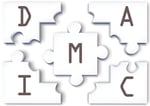More Structure, Less Risk: Comparing Project Management Methodologies

Whether relaunching your homepage or creating new accounting software, projects are one of the largest challenges for any company or organization, since they (almost always) need to be completed within a set time-frame and using a limited amount of financial and personnel resources.
To coordinate and utilize these in the most effective manner, the field of project management arose in the 1950s, fusing business administration, engineering, and mathematics, in order to plan, monitor, guide, control, and complete projects on time and without exceeding the resources committed to them. At the beginning of this process, an assignment or task is given from a higher leadership level (or an external client) to a project manager. This project manager should then oversee the completion of this project, gathering together a team, overseeing their work, and guiding them on how best to complete the task using the resources at hand.
However, selecting the best methods for completing a project, or the right tools, isn't always so easy as it seems, and depends on a variety of different parameters (such as the project's size or its branch). In this article, we're going to introduce you to some of the most popular project management methods, showing how they differ from one another.
Milestone Trend Analysis (MTA)

Milestone trend analysis (MTA) is one of the most effective ways to monitor the internal progress of a project. Often, despite the most detailed plans and preparations, things can and will go wrong within projects, leading to missed due dates and other adverse consequences.
Using MTA, it's possible to determine the extent to which individual work packages are completed on time. These packages contribute to reaching the desired goal of an entire project, and thus, analyzing them makes it possible to determine what sort of delays might be expected. Using this information, it becomes possible to take appropriate measures (i.e., the outsourcing of certain work packages, or the making available of additional capacity).
MTA is completed in graph form, in which the planning period and/or the milestone (horizontal on the X-axis) is entered in addition to the project's progress or the reporting period (vertical on the Y-axis). A date of completion for each milestone is input, as is the current date, and the (in the event of a delay) estimated date of completion.
Good to know: Milestones provide a source of orientation for breaking projects down into goals and levels that can be controlled or monitored. Planning and setting dates always occurs at the outset of a project, ideally, in conjunction with the entire project team.
Sequence of MTA
In comparison to most other project management methods, MTA is relatively easy, following the steps below:
- 1.
Definition of milestone completion dates
- 2.
Setting the reporting periods
- 3.
Checking the milestones during the reporting period
- 4.
Analysis and taking corrective measures, if needed
Should a milestone be delayed for any reason, a new completion date will be set and entered on the Y-axis in the chart. This date can be moved either forward or backward. In both cases, however, the curve won't be level, with the new angle signaling specific "trends". These are:
Horizontal Lines: Completion dates are adhered to as planned.
Rising Lines: The milestone completion dates are later than planned.
Sinking Lines: The milestone completion dates have occurred quicker than planned.
Lean Project Management

As the name suggests, lean project management is primarily concerned with cutting back on unnecessary waste or 'fluff' in terms of both resources and time. At the same time, however, the maximum value should be elicited for the benefit of the client, rather than the stakeholder. In this way, the tools and methods which see use in lean management are linked to the traditional approaches in project management.
The goals of lean management are (among others):
Reducing costs
Cutting back on waste (of resources and time)
Adhering to deadlines
Enhancing quality
Over the course of a lean project, all activities will be regularly measured, with 'non-valuable' processes either reduced or stopped entirely. This creates a significant challenge for the project manager and requires a great deal of communication among all participants.
The Five Principles of Lean Project Management
Lean project management is based on five basic principles, all of which aim at creating more value by eliminating waste:
- 1.
Identify value based on the client's viewpoint: Which activities and processes are necessary to create the greatest possible value from the client's point of view? Which adds more quality to the product?
- 2.
Identify the value stream: Which activities are necessary for the creation of products or the provision of services? Which steps are necessary for providing this? Which parts of the organizations are involved in their creation?
- 3.
Create a flow: How can the entire process (rather than individual steps) be optimized? At which point are difficulties or blockages likely to occur or occurring within the flow? Where are resources being unnecessarily wasted?
- 4.
React to the needs of the client (pull): What are the client's needs? How does the process appear from their viewpoint?
- 5.
Pursue perfection: Which activities and resources add value for the client(s)? Which changes are necessary to improve or perfect the process over the long-term?
Kanban: Evolutionary Improvement

Kanban is a type of agile project management that is particularly useful in guiding production and monitoring its status, thanks to its clear presentation of important data and variables. The principle is based on evolutionary change management, meaning that small steps should be taken gradually, improving the overall character of a product or its accompanying project. In this manner, risk is reduced significantly, since change occurs gradually and incrementally, rather than all at once.
The first step in Kanban is to visualize the existing process and any problems which arise in connection with them through using a so-called Kanban board. This can be a simple whiteboard divided into three or more columns and dotted with post-its or index cards, or a digital tool. Each index card or post-it represents a single task or assignment.
Depending on the status in which the task is, it should be moved from left to right, with those items on the right being completed.
The classic Kanban board is divided into three columns:
A to-do column (on the left), which includes all tasks for which work has not yet begun.
Once work has started on a task, it should be moved to the middle, in-progress column.
Should a task be complete, it will be moved to the done column, on the right.
These columns can be adjusted to the requirements of a particular project. In certain cases, such as large production chains, four, or five-column boards are more practical, since they can better show the entire development process.
Good to know: Kanban boards can be made either physically (such as a whiteboard) or digitally (using special project management software). In most cases, both types of board are used.
Kanban is a very flexible method that doesn't really have a lot of rules. One of its pioneers, David Anderson, who adapted Kanban to the world of software development, noted six guidelines for Kanban. These are:
- 1.
Visualize the workflow: The progress of all tasks or assignments needs to be shown, with a flow from left to right (i.e. from unstarted to completed). Through visualization, each step is made clear (at all times) to all participants.
- 2.
Limit the amount of work: "Work in progress" (WIP) should be limited, with only a specific number of tasks ("tickets") worked on at a particular station, at any given time. This ensures that only so many tasks are begun as can be completed, helping focus to remain centered on the goal(s) at hand.
- 3.
Set clear rules: All rules or guidelines need to be made clear and explicit from the beginning of the project. This means that all participants have a clear idea of what they are working towards. One of the most important manifestations of this is the "definition of done" (DOD) which refers to what the team has agreed upon as comprising completed work.
- 4.
Encourage leadership: Kanban only works when all participants shoulder responsibility and actively contribute towards improving existing processes and procedures.
- 5.
Use models: Models and charts can contribute greatly towards better understanding processes and projects, aiding in uncovering more efficient solutions.
- 6.
Continual improvement: All Kanban processes should regularly undergo evaluation and analysis, to prevent issues, reduce delays, or head off errors. In addition, regular analysis can help to improve existing ways of doing things, making the overall process much more efficient.
Scrum: Team-Based Self-Organization

Scrum is an agile project management framework that has seen wide usage in both software and product development, as well as the service sector. Its methods are iterative-incremental, meaning that all goals of a project are delineated at the project's outset, however, the path taken to reach them is left completely open. In a fashion similar to lean management, Scrum also focuses on achieving the highest degree of customer satisfaction, while maximizing value.
Over the course of limited periods (the aforementioned "sprints"), fully-functional products (or sub-products) are created ("increments") that contribute to, or are necessary for, the finished product. These sprints build upon one another and can last anywhere from a few days to a month.
At its core, every Scrum is composed of participants grouped into one of three different roles, five kinds of activities, three artifacts, and a shared definition of done (DOD). Work is carried out in interdisciplinary teams that collaborate on different projects or aspects of a sprint simultaneously. Progress is reported during daily meetings, and issues or problems are presented and discussed. The so-called product owner is the main contact person within a sprint since they ensure that the development team is working towards the agreed-upon goal while also liaising with those who have assigned it and/or its stakeholders.
Scrum's Values and Principles
Scrum has its own value system, which is based around the following:
Courage to face and accept challenges as well the consequences of one's actions.
Commitment to completing the assigned tasks and contributing to the agreed-upon plans.
Openness, or working in a transparent fashion with regards to progress and artifacts.
Focus and concentration in reaching the project's goals.
Respect for all participants within a project team.
These values provide a good opportunity for Scrum adherents to reflect upon the projects in which they are engaged, allowing them to more easily identify problems either before they arise, or in very early stages.
Good to know: At the end of a scrum project, a so-called "sprint retrospective" is held. This revisits how the project was completed, its processes, and checks where room for improvement exists, documenting it for future implementation in the next sprint.
Six Sigma: Maximizing Organizational Success

Six Sigma is a results-based project management method that primarily serves to enhance business processes. Its main goal is to ensure that procedures are designed which ensure that products are created or services provided with the absolute minimum of errors or defects. In this way, the quality of all processes is continually raised, while total costs are lowered thanks to reductions in unforeseen costs (resulting from defects or errors).
"Sigma" refers to the standard deviation in a normal (Gaussian) distribution. The number of mistakes can be brought to the so-called 'Sigma level' with the usage of statistics, tables, or charts.
Example: Let's say that USPS delivers 365,000 pieces of mail per year (or 1,000 per day) and is classified as a Four Sigma process (meaning 99.349% of the time, errors are not present). This translates into roughly 8 lost shipments (or pieces of mail) per day. Not bad, but, over the course of a year, that's nearly 3,000 lost shipments. A Six Sigma process on the other hand (with an error rate of 0.00034%) would reduce the 3,000 lost shipments per year down to something like 10.
If one proceeds from a normal distribution, nearly all measured values occur within the standard deviation. As a result, a Six Sigma process is veritably error-free, however, this is rarely the case, since the measures needed to ensure this don't justify their (exorbitant) costs. Most businesses settle for either a Three or Four Sigma.
Generally speaking: The higher the Sigma level, the fewer costs are incurred owing to errors or mistakes. In other words, higher Sigma levels translate into greater profits.
Six Sigma projects are executed according to five steps, the so-called DMAIC cycle.
D – Define: The process to be improved needs to be identified and evaluated using data, facts, and goals. After this, problems will be described and documented.
M – Measure: During this phase, the degree to which existing processes conform to customer or client requirements is gauged. Alongside an examination of the project's feasibility for the relevant qualitative aspects, improvements to the measuring system are made.
A – Analysis: As you might have guessed, this phase is about determining causality, specifically, what causes the existing problems to occur in the first place. Procedural and experimental data from the previous phase is evaluated using statistical methods.
I – Improve: The causes determined in the analytical phase for existing problems are overcome through the implementation of relevant solutions. The success or viability of these measures needs to be determined in practice, however.
C – Control: Improvements are monitored following their implementation. This requires continuous oversight and control. When the project is completed, documentation is created for a plan of control.











